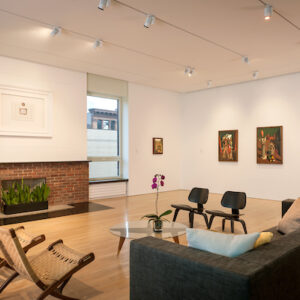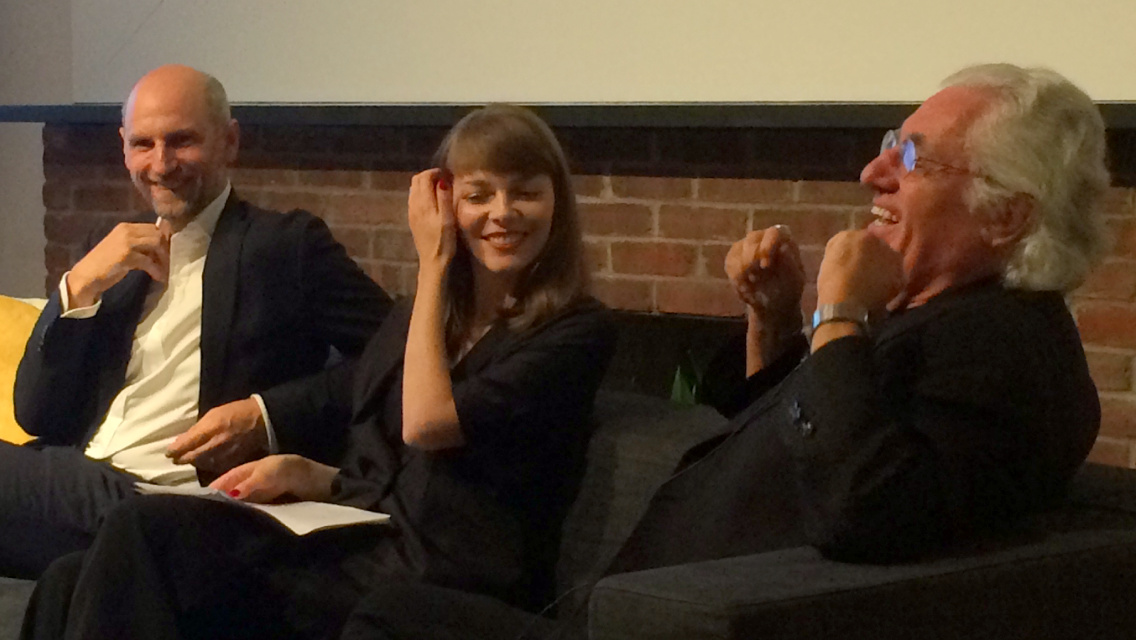On Friday October 21, 2016, as one of the inaugural programs of the Center for Italian Modern Art’s new season dedicated to the modern master Giorgio de Chirico and leading conceptual artist Giulio Paolini, CIMA welcomed the renowned art historian and curator Germano Celant in conversation with MoMA curator Christian Rattemeyer. In front of a full house, Celant and Rattemeyer engaged in an impressive conversation moderated by CIMA 2016-17 Fellow Maria Bremer, interlacing two different generations’ curatorial perspectives.
Celant, the Artistic Director of the Fondazione Prada in Milan, became nationally and internationally renowned after coining the term “Arte Povera” in 1967. He developed the term within the framework of a group show held at Galleria La Bertesca in Genoa—identifying process-oriented practices by young artists who refused to engage with traditional artistic media and languages. Celant associated Giulio Paolini with this movement, including his work in several landmark exhibitions and organizing, in 1972, his first overseas solo show at the Sonnabend Gallery in New York. Back in the early 1970s, Celant, with his militant engagement for the neo-avant-gardes and his impulse to internationalize Italian art, found a kindred spirit in Ileana Sonnabend, who played a seminal role in bringing contemporary European art to America.

This very event at the Sonnabend, and the monograph that accompanied the exhibition, was at the core of CIMA’s Friday night conversation, structured around the year 1972. Christian Rattemeyer, the Harvey S. Shipley Miller associate curator at the Department of Drawings at MoMA and a specialist in the history of exhibitions, framed the conversation with a contribution on the history of exhibition practice from the 19th century onwards, focusing in particular on the dramatic shifts of the late 1960s and early 1970s. More than ever before, and in parallel with the rise of an organizing intermediary, the curator figure, exhibitions became the medium for which new art was produced and through which it became known. Celant in fact recalled that Paolini had specifically produced a series of eight paintings on canvas for his show at the Sonnabend Gallery, meant to provide an exemplary overview of his conceptual approach.
Underpinned by a slideshow of yet unpublished visual materials, the conversation between Celant and Rattemeyer touched upon the collaboration between artists, critics/curators, and art dealers, and the status of monographic publications at the time. The conversation ultimately ventured into the second important collaboration between Celant and Paolini: a major retrospective held at Fondazione Prada in Milan in 2003. Significantly, this second show focused exactly on the period preceding the show at Sonnabend, the time span between 1960 and 1972, stressing its relevance for both the artist’s and the curator’s career. Celant’s 1972 monograph on Paolini was included and re-published in the exhibition catalogue of 2003, which brought about further discussion on the significance of remembering and restaging in exhibition practice.

During an exciting Q&A with the audience, Celant eloquently highlighted the specificities of Italian neo-avant-gardes at the time, stressing the connections that he and his fellow radicals and artist contemporaries felt with Italy’s own avant-garde-ist past, the Futurist movement. He discussed the strong sense of community and collaboration felt among artists in the period, something that was echoed by members of the audience from that generation. He also talked about the usefulness of labels and movements as a way for artists to gain attention, and how those same definitions can then become stifling and limiting. He underscored Paolini’s eccentricity with respect to the neo-avant-gardes, encouraging the audience to grasp the classicist peculiarities and the idiosyncrasies of his conceptual approach, and tying this discussion back to CIMA’s exhibition. Both de Chirico and Paolini in a way have suffered from being “put in a box” and defined by a label—whether Arte Povera or metaphysical/father of surrealism—and CIMA’s exhibition helps us to rethink and reconsider these artists and their legacies.
CIMA films its programs in order to make them available to a wider audience through the research section of its website (due to be launched later this fall). Some videos from previous seasons are already available on CIMA’s Vimeo channel. The Celant program was also broadcast on Facebook Live and that stream can be seen seen on CIMA’s page. The professionally filmed version of the talk will be online sometime later this year.
The author: Maria Bremer, CIMA 2016-17 Fellow.









